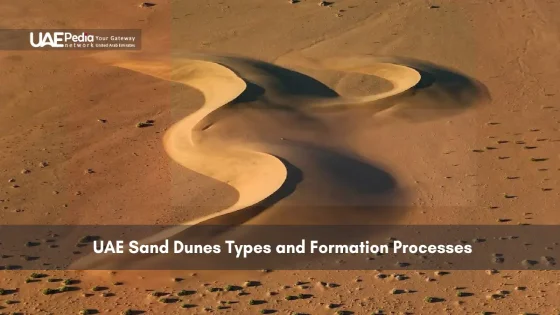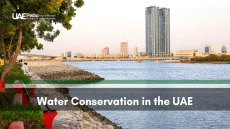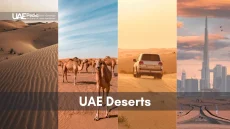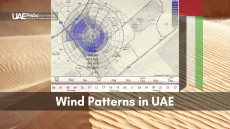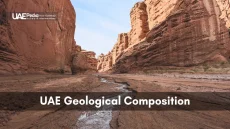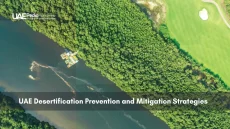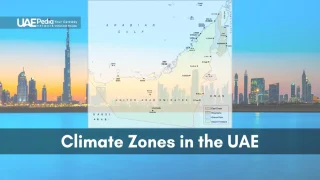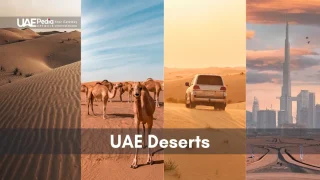The United Arab Emirates (UAE) is full of contrasts. It has 43 nature reserves covering 14% of its land. From the hot dunes of the Rub Al Khali to the Hajar Mountains, the UAE’s landscapes are stunning.
This country, with seven emirates, spans 71,024 square kilometers. It has deserts, mountains, plains, and marine areas. These features make the UAE’s landforms unique and beautiful.
We’ll see the UAE’s vast deserts, dunes, and oases. We’ll also explore dry valleys, coastal marshes, mangrove forests, and salt plains. Let’s discover the UAE’s geographic wonders together.
Overview of UAE’s Geographic Landscape
United Arab Emirates (UAE) has a wide range of landscapes. It has coastal plains and high mountains. These natural features show the country’s geological beauty.
Location and Territorial Composition
Diverse Landforms Found, UAE covers 83,600 square kilometers, ranking 115th in size. It has 772 kilometers of coastline along the Arabian Gulf and Gulf of Oman. Dubai, the second-largest emirate, has 4,114 square kilometers and a 72-kilometer Gulf shoreline.
Climate Impact on Landform Development
UAE’s desert climate affects its landforms. Summer temperatures can reach 40°C. This heat creates sand dunes and rocky areas.
Geological History and Formation
Millions of years of tectonic activity and sea level changes have shaped the UAE. This has led to a variety of natural landforms. These include:
- The vast Rub’ al Khali desert
- Coastal plains along the Arabian Gulf
- The majestic Hajar Mountains
| Landform | Characteristics | Geological Age |
|---|---|---|
| Rub’ al Khali Desert | Sand dunes, gravel plains | Quaternary |
| Hajar Mountains | Limestone, ophiolites | Cretaceous |
| Coastal Plains | Sabkhas, mangroves | Recent |
This shows the UAE’s geological variety. It has ancient mountains and new coastal areas.
Landforms of the UAE

The United Arab Emirates has many different landforms. These include vast deserts and rugged mountains. Each part of the landscape tells a unique story.
The desert is the biggest part of the UAE. The Rub Al Khali, or Empty Quarter, has huge sand dunes. These dunes were made by wind and time.
Mountain ranges are also important in the UAE. The Hajar Mountains, including Jebel Jais, are the highest peaks. They offer a cooler climate and home to many plants and animals.
The UAE’s coastlines along the Arabian Gulf and Gulf of Oman are rich in life. They have over 500 fish species and marine mammals. The wetlands, like mangrove habitats and salt plains, are also vital.
Oases are key in the UAE’s geography. The Al-Ain Oasis is the UAE’s greenest spot. It shows how people used to manage water in the desert.
| Landform | Key Feature | Ecosystem |
|---|---|---|
| Rub Al Khali | Largest sand dunes | Desert |
| Jebel Jais | Highest peak (1,934m) | Mountain |
| Arabian Gulf Coast | Rich marine life | Coastal and Marine |
| Al-Ain Oasis | Traditional water management | Wetland |
Coastal and Marine Formations
The UAE’s coast is full of natural wonders. From the Arabian Gulf to the Gulf of Oman, these shores have unique features. They shape the country’s landscape and support rich marine ecosystems.
Arabian Gulf Coastline Features
The Arabian Gulf coast of the UAE has low-lying shores and shallow waters. It’s home to many sandy beaches and lagoons. These conditions are perfect for marine habitats.
Gulf of Oman Coastal Structures
The Gulf of Oman coast is different. It has steep cliffs and rocky outcrops. These are shaped by erosion, creating dramatic landscapes.
Marine Ecosystems and Coral Reefs
UAE marine ecosystems are full of life. The country’s waters have vibrant coral reefs. These reefs are key for fish breeding and protect the shores.
These coral reefs are home to many marine species. You can find colorful fish, sea turtles, and dugongs here.
Mangrove Habitats and Salt Plains
Mangrove forests, or qurms, are vital in the UAE’s coastal ecosystem. They act as natural barriers against erosion. They also provide homes for many bird species.
Along the coast, salt plains or sabkhas create unique landscapes. These have been forming for thousands of years.
| Coastal Feature | Ecological Importance | Conservation Status |
|---|---|---|
| Coral Reefs | Fish breeding, shore protection | Under threat from climate change |
| Mangrove Forests | Carbon sequestration, habitat provision | Protected and expanding |
| Salt Plains | Unique ecosystem, mineral production | Stable, some areas protected |
The UAE is working hard to protect its coast and marine formations. With rising sea levels, it’s crucial to save these diverse ecosystems.
Mountain Ranges and Valley Systems
The UAE has many landforms, with mountains and valleys making a beautiful scene. The Hajar Mountains are a key part of the UAE, running along the east. They offer amazing views and home to unique plants and animals.
Hajar Mountains Composition
The Hajar Mountains cover the UAE’s east, reaching up to 1,300 meters high. These mountains show the area’s geological history. They have exposed rock layers that tell us about Earth’s past.
Wadi Formations and Characteristics
UAE wadis, or dry riverbeds, spread across the mountains. In cooler months, they turn into green oases. These places are great for hiking and seeing nature.
Rock Formations and Geological Features
The Hajar Mountains have amazing rock formations like limestone cliffs. These features give us a peek into the UAE’s ancient history. They draw geologists and tourists.
| Feature | Description | Significance |
|---|---|---|
| Hajar Mountains | Reach up to 1,300 meters | Dominate eastern UAE landscape |
| UAE Wadis | Dry riverbeds | Transform into oases during rainy seasons |
| Rock Formations | Limestone cliffs, sedimentary layers | Reveal millions of years of geological history |
Desert and Sand Formations
The UAE’s landscape is filled with vast deserts. These deserts show off amazing UAE dune formations. From the Arabian Gulf’s southern coast to the famous Rub Al Khali, these sandy areas are both beautiful and tough.
Rub Al Khali (Empty Quarter)
The Rub Al Khali, or Empty Quarter, is a natural wonder. It covers 650,010 km2 across the UAE, Saudi Arabia, Oman, and Yemen. This very dry area gets less than 50 mm of rain each year.
Despite being called the Empty Quarter, it’s not empty. It’s home to special plants, spiders, and rodents that can survive the harsh conditions.
Sand Dune Ecosystems
UAE dune formations make a changing landscape. Some dunes are as tall as 250 meters, surrounded by gravel and gypsum plains. These dunes come in different shapes, like crescents and stars.
The wind, sand, and a few plants create a variety of desert shapes. This variety is seen across the UAE’s plains and plateaus.
Oasis Landscapes
UAE oases are green spots in the desert. They provide water and support special ecosystems. These green areas, mainly date palms, are common in Abu Dhabi.
Oases have helped desert communities survive and grow for centuries. They offer food and shelter in the harsh desert.
| Feature | Description |
|---|---|
| Rub Al Khali Area | 650,010 km2 |
| Dune Height | Up to 250 meters |
| Annual Rainfall | Less than 50 mm |
| Main Oasis Vegetation | Date Palms |
The UAE’s landforms are a mix of natural wonders. From the Rub Al Khali’s sand dunes to the Hajar Mountains’ peaks. These areas support unique life and show the UAE’s geological past. UAE’s landscapes, like coastal plains and deserts, are beautiful. They are perfect for both locals and tourists.
UAE is growing fast, like other places. With more people living near the coast, it’s important to protect the environment. Rising sea levels are a big concern, with up to 1.10 m expected by 2100.
Ras Al Khaimah shows the UAE’s goal to save nature while growing its economy. It has a long history, with 1,000 sites and 7,000 years of people living there. Keeping the UAE’s landforms safe for the future is a big goal.



